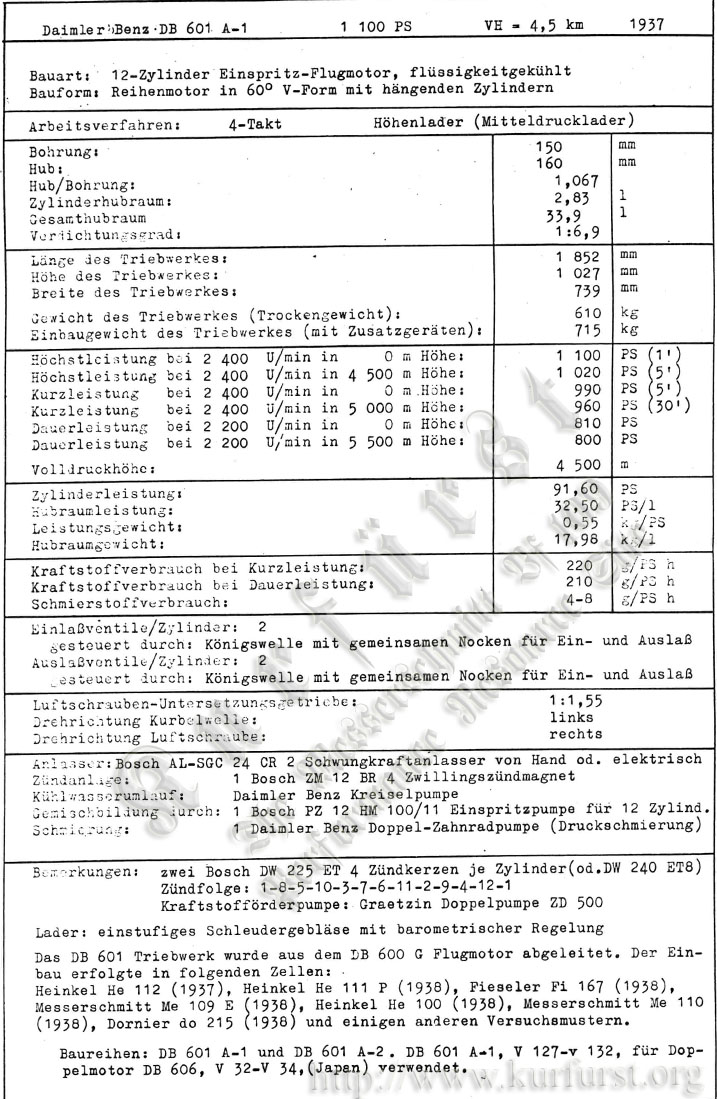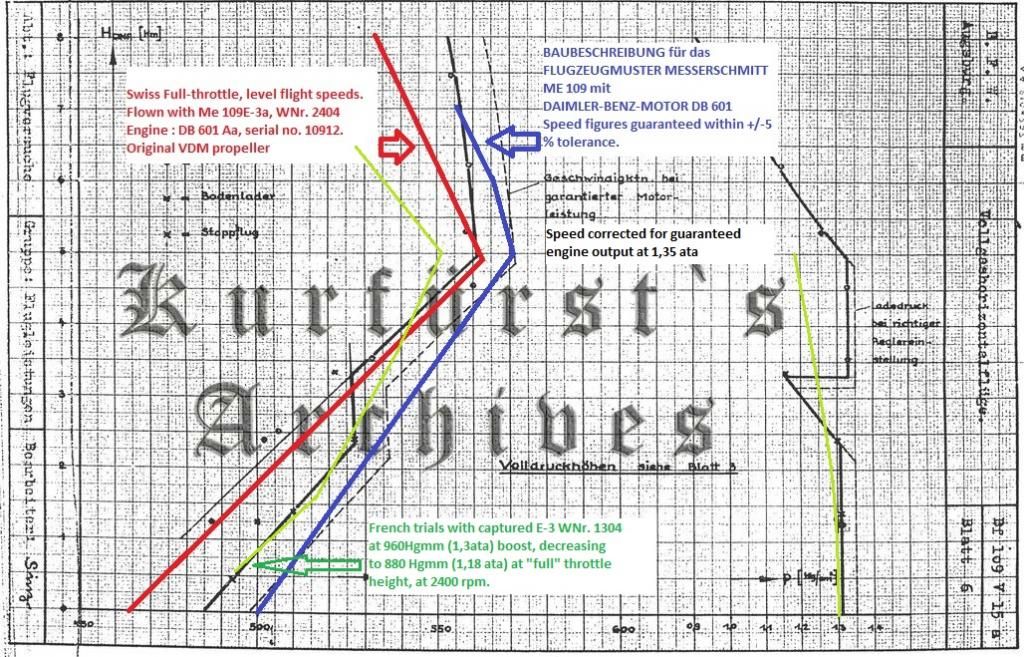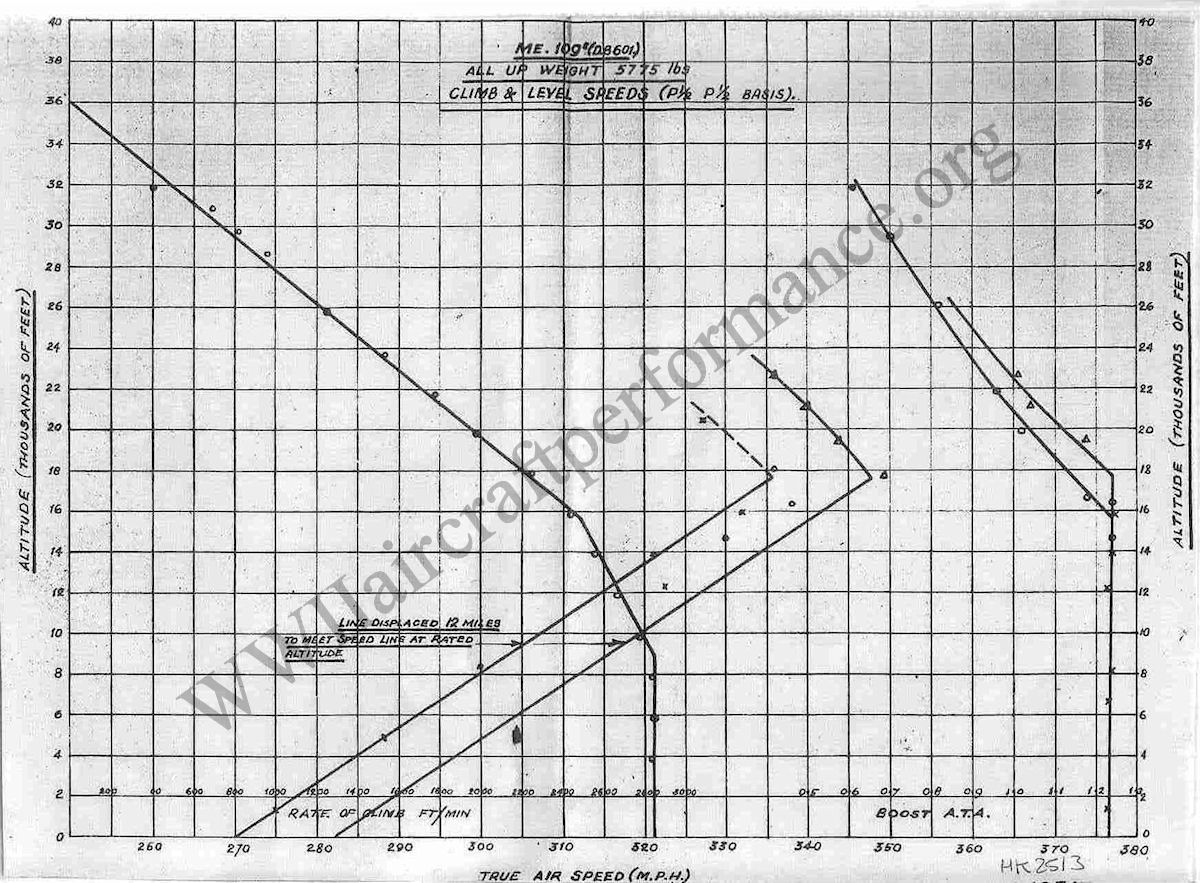
 |
|
#11
|
|||
|
|||
|
I.
The Me 109E had at least four fitting and used during the Battle of Britain, with different boost and outputs. 1. The DB 601A-1 with the old type supercharger, 1.30 ata for five min and 990 PS, and 1.40 ata for 1 min and 1100 PS. Rated altitude being 4000m. 2. The DB 601A-1 with the new type supercharger, 1.30 ata for five min and 990 PS, and 1.40 ata for 1 min and 1100 PS. Rated altitude being 4500m.  3. The DB 601Aa with the old type supercharger, 1.35 ata for five min and 1045 PS, and 1.45 ata for 1 min and 1175 PS. Rated altitude being 3700m (altitude output was otherwise very much like the DB 601A-1 / old s/c, though it is an open question wheter the new s/c was fitted to the Aa as well. So far no evidence to that though.) This is the type we have in the sim.  4. The DB 601N, 1.35 ata for five min and 1175 PS. Rated altitude being 4800m. (there was a second type of 601N, mounted in one in the 109F had better supercharger and IIRC 5200 m rated altitude)  II. Therefore, it is pointless to compare our 601Aa equipped Emils performance (1.35ata) to real life tests of DB 601A-1 equipped Emils at 1.3ata. It makes about as much sense as checking Spitfire I performance from the crayon +12 boost graph It should of course match the real life DB 601Aa at 1.35ata (V-15a, Baubeschreibung "5%" specs, Swiss trials of serial no. 2404 - these all have Aa, although it's quite clear the Swiss graph is only showing high speed supercharger, ie. Hohenlader performance - note the almost exact match between V15a Hohenlader and the Swiss single speed graph)  III. Misc. comments 1. The "French 109" was an E-3, not an E-1: WNr. 1304. Besides the aerodynamic differences between the E-1 and E-3 are marginal, probably in the order of 1-2 kph. It seems to loose manifold pressure continously with altitude - I suppose the use of French lubrication of oils instead of German synthetics may be at culprit (since the hydraulic coupling was using this oil). It had a DB 601A-1 and operated at 1,3ata, ie. lower boost/power than our E-1/E-3/E-4s. 2. The WNr. 1791 and 1792 tests can be easily forgotten given that - this was never a performance tests, but a speed comparison with various fittings: As it notes clearly - Geschwinigkeitsunterscheid - comparison of speed -as a result only the relative values (guns in / out, slats sealed/not sealed) were interesting Mtt AG in these tests, they were not made to get absolute values. - they do not have the same 1.35ata Aa engine as our Bf 109E has, but a weaker 601A at 1.3ata, which developed about 55 HP less. - in addition report clearly notes the engine outputs were not corrected for guaranteed engine performance, which means we/they have no idea how much those engines were developing. Again, given that all those two reports were supposed to show was what's the speed difference with this thing on and that thing off this hardly concerned Mtt at the time. 3. The fact that Mtt. accepted the V15a trial results and guaranteed them within 5% for the ca. 4000 Emils produced needs very little comment. 4. The "nazi propaganda" (pathethic, even for Mike It's one chapter from a 75 page document describing the airframe, powerplant, equipment, armament, performance, as well as the all the instruments. It's hardlly a two page "marketing material" as some like to pretend - besides the fact that the specs are guaranteed and are based on flight tests.
__________________
Il-2Bugtracker: Feature #200: Missing 100 octane subtypes of Bf 109E and Bf 110C http://www.il2bugtracker.com/issues/200 Il-2Bugtracker: Bug #415: Spitfire Mk I, Ia, and Mk II: Stability and Control http://www.il2bugtracker.com/issues/415 Kurfürst - Your resource site on Bf 109 performance! http://kurfurst.org 
|
|
#12
|
||||
|
||||
|
Quote:
Swiss test: You seem to use the 'Original VDM' curve. I don't know what the other curves represent so can you please explain? I picked up somewhere that the test was at 1.35ata. Can you find a source for that? V15a: This was conducted at 1.31ata at low level and 1.3ata above 3,300m. How can I reproduce that in CoD? (I don't usually fly the 109). How can we be sure which 109 engines are supposed to be modelled in CoD (or which should be)? What configuration does the "Handbook" represent? EDIT: I can't seem to find weights of the Swiss and V15a aircraft. Also, was the V15a version a fully loaded military configuration? Thanks,
__________________
klem 56 Squadron RAF "Firebirds" http://firebirds.2ndtaf.org.uk/  ASUS Sabertooth X58 /i7 950 @ 4GHz / 6Gb DDR3 1600 CAS8 / EVGA GTX570 GPU 1.28Gb superclocked / Crucial 128Gb SSD SATA III 6Gb/s, 355Mb-215Mb Read-Write / 850W PSU Windows 7 64 bit Home Premium / Samsung 22" 226BW @ 1680 x 1050 / TrackIR4 with TrackIR5 software / Saitek X52 Pro & Rudders Last edited by klem; 10-09-2012 at 03:38 PM. |
|
#13
|
||||||
|
||||||
|
Quote:
Other than that, sadly I do not have the rest of this report, and I would be glad if someone has it. Quote:
Quote:
What should be is a different question - any of the above engines in fact, but I guess 1C had to choose the one which they had the best documentation for. Ideally we would have a gazillion Emil types with similiar chaos as with Rotol, DH, 87 and 100 octane Spits and Hurries.. but it's impossible to tell how many had A-1 old, A-1 new s/c, or Aa, apart from that Aa amounted to about 1/3 of all 601 production We can tell the number of Ns, because they were relatively rare.. Bottomline is, since we have Aa variant, we should have the Aa specs. The Aa is a bit better at low altitude (ca. +50 PS), an A-1 with the new supercharger is better at high altitude (ca. +50 PS again). Quote:
Engine is certainly 601A-1, probably early one. Problem is the engine ratings are not shown, and in these kind of papers it was quite common to use 30-min (1.2x-ish ata) ratings instead of full power. IIRC comparison of the Handbook with RAE's testing of the "French 109E(-3)" point strongly to that the handbook indeed shows 30 min performance only and not the full ratings. Quote:
The V15a weights are unknown, although it's noted that the aircraft is serial production form, with 4 MGs installed. Exhaust covers were missing and the engine cowling was 'raw' (I suppose this means unpainted), the rest of the aircraft had standard camoflage. the s/c inlet was squarish and looks very much like the standard one on the Emil; they expected that a rounded intake would work better (as we know this waited until the 109F). All in all Mtt expected further improvements in performance with these added. Ammo may or may not be installed, or ballasted, but in any case, a few dozen kgs in or out has next to no effect of a fighter's top speed. Landing gear retracted, tailwheel out. radio antenne. All in all it was pretty much the stock (DB 601Aa powered) E-1 in every way. Quote:
__________________
Il-2Bugtracker: Feature #200: Missing 100 octane subtypes of Bf 109E and Bf 110C http://www.il2bugtracker.com/issues/200 Il-2Bugtracker: Bug #415: Spitfire Mk I, Ia, and Mk II: Stability and Control http://www.il2bugtracker.com/issues/415 Kurfürst - Your resource site on Bf 109 performance! http://kurfurst.org 
|
|
#14
|
||||
|
||||
|
OK, thanks. I'll keep the V15a, Swiss and Handbook curves only and plot the CoD 109E-3 against them.
I'll start the tests again at 1.35ata, 2400rpm, 1/4 radiator. I guess we don't have access to the manual 2-speed gearing, perhaps its automatic. That might account for the strangely shifting plot I got first time but... I'll start again.
__________________
klem 56 Squadron RAF "Firebirds" http://firebirds.2ndtaf.org.uk/  ASUS Sabertooth X58 /i7 950 @ 4GHz / 6Gb DDR3 1600 CAS8 / EVGA GTX570 GPU 1.28Gb superclocked / Crucial 128Gb SSD SATA III 6Gb/s, 355Mb-215Mb Read-Write / 850W PSU Windows 7 64 bit Home Premium / Samsung 22" 226BW @ 1680 x 1050 / TrackIR4 with TrackIR5 software / Saitek X52 Pro & Rudders |
|
#15
|
|||
|
|||
|
sorry, if..., but what you can tell about soviet trials of emil? 440 km/h at SL (5 min 1.35 ata (980mm))...
|
|
#16
|
|||
|
|||
|
I don't think that the supercharger speed could be set from the cocpit. However the system could certainly be. Supercharger speed on the 601 was regulated by two oil pumps. The amount of oil in the sytem decided oil pressure, and thus the amount of slip, and so supercharger speed.
One pump supplied oil at a constant rate. That's essentially a fixed speed, that's why the DB power curve near SL is a straight line. The second pump supplied oil at a variable rate. The rate was decided by a barometer (increasing with altitude). It did not operate at all until about 1.5 - 2 km, this is where the "smooth" power curve typical of DB engines begin. If you switch this second pump off, you essentially have the low speed gear (Bodenlader, the Brits used MS gear for that term). If you set this to deliver maximum amount of oil, the supercharger will run at max speed at all altitudes, it's essentially like a 2nd or high altitude gear (Hohenlader), exactly as on a two speed Merlin's FS gear. Naturally like the previous, it will develop less power at low altitude, hence lower speeds will be achieved (since running the s/c at full robs the engine of power, and there's a large loss power from increased charge temperatures). A couple of later tests (i.e. Rechlin G-6 curves) show this was used sometimes, I believe because setting up the supercharger to minimum/maximum speed like that ensured that irregularities with the hydraulic coupling and supercharger speed did not interfere with accurate measurements, and SL speed and rated alt. speed could be easily measured. The interim was easy to interpolate, given the engine curves. I pretty sure the same was followed by the Swiss and possible the "Handbook" test (which I believe may possibly replicate a rechlin trial's result). The US tests were quite clearly done this way, too. Otherwise Quite simply no amount of drag or power difference between individual planes can explain no less than 40 kph top speed at low levels, while high altitude speed is pretty much the same in all tests. That alone rules out DRAG differences, since those would show up at all altitude, so it's NOT any perceived difference between the V15a 'prototype' Propeller was the same as the serial type, it's clear from V15a papers. That leaves POWER. To have such huge differences in speed, the power differences have to be present only at low altitudes, and has to amount to a massive scale, like 100-150 horsepower less. There was simply no such individual difference between production engines. And here's the problem. V15a's engine was bench tested, which shatters any speculation about how the supercharger worked or not. They measured about 1015 PS in flight, which is the similar to the normal production output of the 601A series. That 1015 PS is the same power wheter it's a pre-production or production engine, or if Willy trained squirrels to drive the propeller. There was, however, such huge difference between the high/low supercharger gears of the DB 601A.
__________________
Il-2Bugtracker: Feature #200: Missing 100 octane subtypes of Bf 109E and Bf 110C http://www.il2bugtracker.com/issues/200 Il-2Bugtracker: Bug #415: Spitfire Mk I, Ia, and Mk II: Stability and Control http://www.il2bugtracker.com/issues/415 Kurfürst - Your resource site on Bf 109 performance! http://kurfurst.org 
|
|
#17
|
|||
|
|||
|
Quote:
__________________
Il-2Bugtracker: Feature #200: Missing 100 octane subtypes of Bf 109E and Bf 110C http://www.il2bugtracker.com/issues/200 Il-2Bugtracker: Bug #415: Spitfire Mk I, Ia, and Mk II: Stability and Control http://www.il2bugtracker.com/issues/415 Kurfürst - Your resource site on Bf 109 performance! http://kurfurst.org 
|
|
#18
|
|||
|
|||
|
Quote:
That is not to say that I don't think the 109E-3/E-4 as currently constituted are too slow in CoD, (although proportionately MUCH better modelled than the Spitfire and Hurricane), they are likely too slow, however... One, you should be aware the designation 'V15', indicates a pre-production, test aircraft, which may or may not include the standard loadout or equipment of the production version, this is not an E-3 or E4 or even an E-1, and this cannot be considered a test of a standard factory variant, it was done in 1938, before the E-3 was in production and before the tests done of the standard variants. For example, a later 1939 test of an actual German production 109E3 to determine the loss of speed as a result of the fitting of wing guns shows a top speed at sea level of 467 km/hr, less than shown with the V15 variant. The E-3 test was done at 1.3 ata, not full 1.4 boost, so the speed would be higher at a higher boost, with the additional 100 PS that would give, but it is hard not to accept the document is more relevant than the V15 document. Tests of the existing game 109E3 should see a speed of 467 km/hr at 1.3 ata, something which I believe it fails to achieve.  Two, in reference to another example, the Swiss tests, indications are the DB601Aa engine was an export only variant. And many facts bear this out. For example, none of the aircraft captured during the BoB had the Aa version of the DB-601 engine. And the German manual for the DB601A or B, which includes many of the charts seen on the WWII site and Kurfurst's site, and which is dated on issuance October of 1940, with extensions, has no reference to the DB601Aa. It can be downloaded here: http://www.scribd.com/doc/32387854/Handbuch-DB-601-A-B The DB601A/B engine was listed at 1100 PS at sea level, but that actually wasn't it's highest output point, that was at approximately 1.7 thousand meters, when it outputted approx. 1170 PS. A translated captured German document which agrees with the suggestion no DB601Aa were used in the Luftwaffe aircraft is a bulletin the Germans themselves issued in November of 1940 allowing engine rpm to be increased over a certain altitude, and the only engines mentioned were the DB-601A or B and N.  In any case, dismissing the results of the British and French tests as irrelevant is not necessarily the correct choice as there is very detailed information provided there which can shed light on the 109E's performance. And for example, the British Rolls Royce tests tend to agree with the test of the E-3 I have shown above. Messers Rolls Royce did their speed and climb tests of a captured 109E-3 at 1.23 ata, the 30 minute limit boost level, and achieved a speed of 285 mph/456 km/hr at sea level at that boost. Obviously top speed at 1.3 and 1.4 ata would be higher, but you can see a linkage with the German E-3 test at sea level.  So as I posted before, careful consideration of ALL the facts is important when coming to a conclusion re. performance. Last edited by *Buzzsaw*; 10-09-2012 at 07:09 PM. |
|
#19
|
|||
|
|||
|
Buzzsaw - You're mixing something here. The export thingy was the Bf 109 E-3a (in which the a denotes the export use). The Romanians received the same type as did the Japanese (the latter for tests). I have the full Bf 109 E manual compendium from Luftfahrtarchiv Hafner (reproduced originals) and the DB 601Aa is listed as engine type.
BTW you accuse Kurfürst of " a viewpoint". If I were you I'd be very quiet since you obviously represent the other side of that particular medal. |
|
#20
|
||||
|
||||
|
Quote:
Buzzsaw is certainly making a good point. The FTH of all 109s in game is 4500m, suggesting that DB 601A-1 version is modelled. 467 kph at S/L at 1.3 ata seem very reasonable (water cooler 3/4 closed). The test were not recalculated for engine's guaranteed power yet.
__________________
Bobika. |
 |
|
|